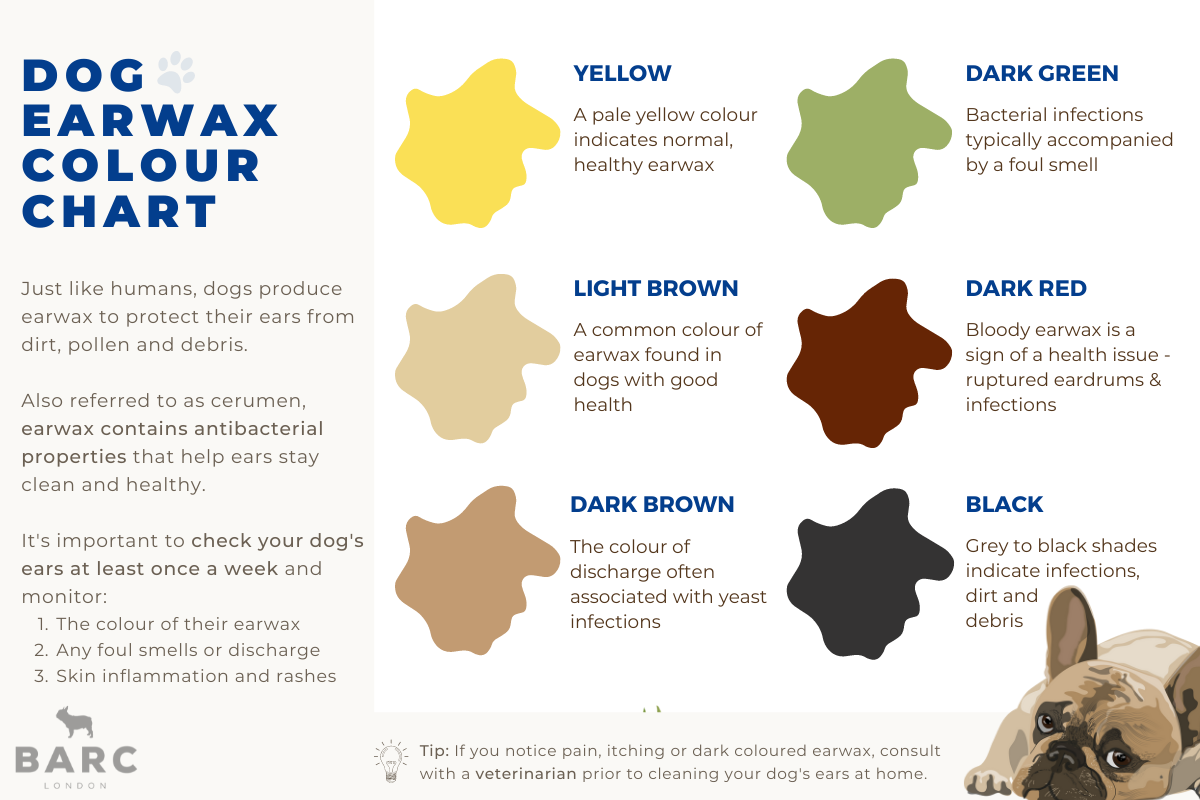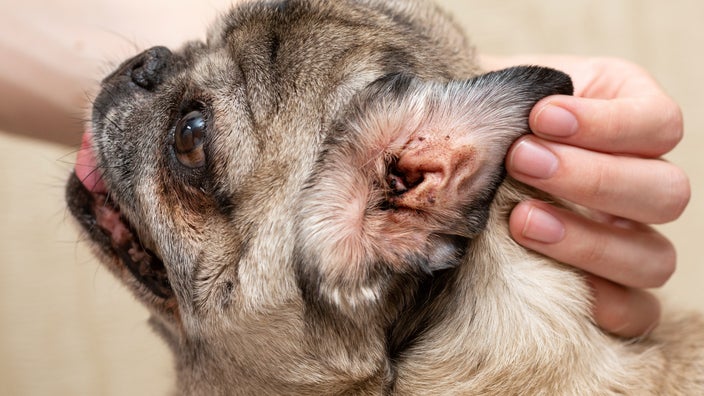To know if your dog has an ear infection, look for symptoms like head shaking, pawing at the ear, foul odor, or discharge. Redness or swelling in the ear canal can also indicate an infection.
Ear infections in dogs are common and can cause discomfort, so it’s important to identify and address them promptly. Knowing the signs of an ear infection will help you provide the necessary care for your pet’s health and well-being. Seeking veterinary attention is crucial if you suspect your dog may have an ear infection, as they can provide an accurate diagnosis and appropriate treatment to alleviate your dog’s discomfort and prevent any further complications.
Understanding the symptoms will enable you to take proactive measures to ensure your dog’s ear health.
Signs And Symptoms Of Ear Infection In Dogs
A dog’s ears are not just adorable, floppy parts of their body; they are also important for their overall health and well-being. Unfortunately, dogs are prone to ear infections, which can cause discomfort and pain. It is crucial for dog owners to be able to recognize the signs and symptoms of an ear infection in their furry companions, so that appropriate care can be provided.
Frequent Scratching Or Shaking Of The Head
One of the most common signs of an ear infection in dogs is frequent scratching or shaking of the head. If you notice your dog repeatedly scratching at their ears or shaking their head vigorously, it could indicate an issue. This behavior is often an attempt to alleviate the irritation and discomfort caused by the infection.
Unusual Behavior
In addition to frequent scratching and head shaking, dogs with ear infections may display unusual behavior. Keep an eye out for any changes in your dog’s behavior, such as increased irritability, restlessness, or a decrease in appetite. These changes may be a result of the pain and discomfort they are experiencing due to the infection.
If you notice your dog avoiding activities or behaviors that they once enjoyed, it could be a sign of an ear infection. For example, if your dog suddenly refuses to play with their favorite toy or becomes hesitant to go on walks, it may be due to the pain in their ears.
Moreover, some dogs may exhibit signs of depression or lethargy when they have an ear infection. Keep an eye out for any unusual behavior or lack of energy that could suggest your dog is not feeling well.
Other signs and symptoms of an ear infection in dogs may include:
| Signs | Symptoms |
| Bad odor from the ears | Redness or swelling of the ear canal |
| Discharge or pus | Visible discomfort when touched near the ears |
| Excessive ear wax | Tilting of the head to one side |
| Loss of balance | Difficulty hearing |
| Scabs or crusts on or around the ears | Excessive scratching of other body parts |
If you observe any of these signs or symptoms in your dog, it is important to consult a veterinarian for proper diagnosis and treatment. Ear infections can be caused by various factors, such as allergies, ear mites, or moisture trapped in the ear canal, and identifying the underlying cause is crucial in providing the appropriate care.
Remember, early detection and treatment of ear infections can help alleviate your dog’s discomfort and prevent further complications. So, stay vigilant and keep an eye out for the signs and symptoms discussed.

Credit: www.barclondon.com
Methods For Examining Your Dog’s Ears
To ensure the health and well-being of your furry friend, it’s essential to regularly examine your dog’s ears for any signs of infection. Methods for examining your dog’s ears can help you catch potential problems early and seek medical attention promptly. Let’s explore how you can perform a simple ear examination at home.
Gently Lift The Ear Flap
To start, gently lift your dog’s ear flap and take a close look at the inner ear. This involves carefully holding the ear flap between your fingers and lifting it upwards. Ensure that your dog is comfortable and remains still throughout the process. If your dog shows signs of discomfort, it’s advisable to seek the assistance of a professional.
Look For Redness, Swelling, Or Discharge
Upon lifting the ear flap, look for any redness, swelling, or unusual discharge. Redness and swelling can indicate inflammation, while discharge may suggest an infection. A healthy ear should have a pinkish color and appear clean without any foul odor or excessive wax buildup. Mild debris accumulation is normal, but anything excessive warrants further inspection.
Common Causes Of Dog Ear Infections
Ear infections are a common problem in dogs and can cause them discomfort and pain. It is essential for dog owners to recognize the signs of ear infections and understand their causes. By being aware of the common causes of dog ear infections, you can take proactive measures to prevent them from occurring in your furry friend. Here are some of the most frequently encountered culprits.
Ear Mites
These tiny parasites are a common cause of ear infections in dogs. Ear mites can cause intense itching and irritation in your dog’s ears, leading to inflammation and infection. They are highly contagious and can quickly spread from one pet to another. Regular ear checks and prompt treatment are crucial in preventing and managing ear mite infestations.
Allergies
Allergies are another significant contributor to dog ear infections. Environmental allergens such as pollen, dust, and mold, as well as food allergies, can lead to inflammation in the ears. This inflammation creates a warm and moist environment that promotes bacterial and yeast growth, resulting in an ear infection. Identifying and addressing your dog’s allergies can help prevent recurring ear infections.

Credit: www.goodrx.com
When To Seek Veterinary Care
Worried about your furry friend’s health? Learn how to spot the signs of an ear infection in your dog and when it’s time to seek veterinary care.
Persistent Or Worsening Symptoms
If you notice that your furry friend’s ear infection symptoms persist or even worsen after a few days of at-home care, it’s time to seek professional veterinary assistance. Persistent symptoms may include:
- Continual scratching or rubbing of the affected ear
- Intense redness or swelling in the ear canal
- Prolonged head tilting or shaking
Your dog’s discomfort and well-being should be your top priority. So, if you observe any of these persistent symptoms, it’s important to consult a veterinarian for a proper diagnosis and appropriate treatment.
Foul Odor Or Discharge From The Ear
If you detect an unpleasant smell coming from your dog’s ear or notice any discharge present, consulting a veterinarian is highly recommended. Typical signs of a problematic ear infection may include:
- Yellow, brown, or bloody discharge
- A noticeable increase in wax production
- A foul odor emanating from the ear
An unpleasant odor or abnormal discharge may indicate a more severe infection or an underlying issue that requires immediate attention. Initiating prompt veterinary care in such cases is essential to prevent complications and to ensure your furry companion receives the necessary treatment.
Treating And Preventing Ear Infections In Dogs
Does your dog constantly scratch their ears? Are they shaking their head more often? These could be signs of an ear infection. Look out for redness, discharge, or foul odor in their ears, and consult a vet for proper diagnosis and treatment.
Administering Prescribed Medication
Administering prescribed medication is a crucial step in treating ear infections in dogs. Once your veterinarian has diagnosed your dog with an ear infection, they will likely prescribe medication to help clear up the infection and provide relief from any discomfort your furry friend may be experiencing. It’s important to closely follow the instructions provided by your vet and ensure that you administer the medication as directed.
The medication prescribed for your dog’s ear infection may come in the form of ear drops, ointments, or oral antibiotics. To administer ear drops or ointments:
- Gently lift your dog’s ear flap and hold it up to expose the ear canal.
- Place the prescribed number of drops or a thin strip of ointment into the ear canal.
- Gently massage the base of the ear to help the medication penetrate the ear canal.
- Allow your dog to shake their head, which helps to distribute the medication throughout the ear.
If your vet has prescribed oral antibiotics, you can mix the medication with your dog’s food or administer it directly by placing it at the back of their tongue and encouraging them to swallow. Remember to always complete the full course of medication, even if your dog’s symptoms improve, to ensure the infection is completely eradicated.
Regular Ear Cleaning And Maintenance
Regular ear cleaning and maintenance play a vital role in preventing ear infections in dogs. By taking proactive measures and keeping your dog’s ears clean, you can minimize the risk of infections and maintain their overall ear health.
To clean your dog’s ears:
- Gently lift your dog’s ear flap and examine the ear canal for any signs of redness, inflammation, discharge, or unpleasant odor.
- If everything looks normal, moisten a clean gauze or cotton pad with an approved ear cleaning solution.
- Gently wipe the inside of your dog’s ear, being careful not to insert the pad too deeply into the ear canal.
- Repeat the process with a fresh pad for the other ear, if necessary.
- Regularly check your dog’s ears for excessive wax buildup, foreign objects, or signs of irritation, and consult your vet if you notice any abnormalities.
It’s essential to use an ear cleaning solution specifically designed for dogs, as human products can be harmful to their sensitive ears. Avoid using cotton swabs or other objects that can potentially damage the ear canal.
By incorporating regular cleaning and proper ear maintenance into your dog’s routine, you can significantly reduce the risk of ear infections and ensure their ears stay healthy and comfortable.

Credit: www.bostonveterinary.com
Frequently Asked Questions Of How To Know If My Dog Has An Ear Infection
How Can I Tell If My Dog Has An Ear Infection?
If your dog is scratching their ears, shaking their head, or showing sensitivity when you touch their ears, it could indicate an ear infection. Other signs include redness, swelling, discharge, and a foul odor. It’s best to consult your vet for an accurate diagnosis and proper treatment.
What Causes Ear Infections In Dogs?
Ear infections in dogs can be caused by a variety of factors, including allergies, foreign objects in the ear, excessive moisture, ear mites, and underlying health conditions. Understanding the underlying cause can help prevent future ear infections and ensure proper treatment.
How Can I Prevent Ear Infections In My Dog?
To prevent ear infections in your dog, it’s important to keep their ears clean and dry, especially if they have long floppy ears. Regularly check for any signs of irritation or infection and promptly address them. Additionally, addressing any underlying allergies or health conditions can help prevent recurring ear infections.
Conclusion
Being able to identify the signs of an ear infection in your dog is crucial for their health and well-being. By paying attention to symptoms such as head shaking, scratching, and odor, you can take the necessary steps to seek veterinary care and alleviate your furry friend’s discomfort.
Remember to clean their ears regularly and follow your vet’s recommendations to prevent future infections. Your dog will thank you for it!


